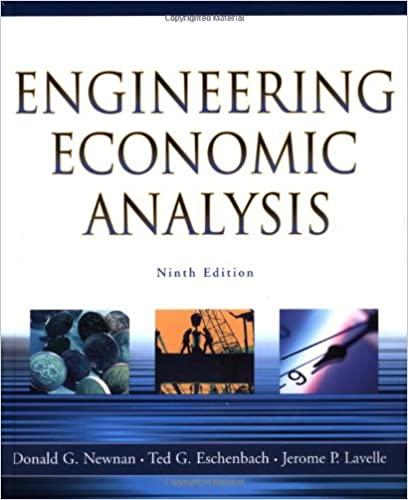Question
MPDGo, a moped company, buys chains from Chains-R-Us, an outside producer of moped components. MPDGo has an exclusivity contract with Chains-R-Us for the next 8
MPDGo, a moped company, buys chains from Chains-R-Us, an outside producer of moped components. MPDGo has an exclusivity contract with Chains-R-Us for the next 8 years. According to the contract, if MPDGo decides to stop buying the chains from Chains-R-Us, MPDGo would have to pay immediately $100,000 in cash to Chains-R Us as a contract-breach fee.
MPDGo uses one chain per moped for its 200,000 mopedssold per year. MPDGo expects this saleslevel to remain steady in the future, i.e., for the next 8 years, that is at time 1, 2, …, 8. MPDGo is considering exiting the business anyway at the end of the next 8 years, that is at time 8.
The MPDGo chief operating officer believes the chains can be made inhouse at an additional cost of $0.40 per chain. The quality control is much better inhouse so the chief operating officer believes that the overall quality of the mopeds is slightly better and MPDGo will be able to add $1.0 to the selling price per moped without reducing the 200,000 mopeds sold per year.
The new machinery needed to produce the chains inhouse costs $260,000 and the entire cost would be depreciated straight line to zero over the 10 year life of the machinery. Moving to inhouse production would require $26,000 of inventory and other working capital upfront (that is at time 0) and maintain it at this level up to year 7, that is time 7, and then recovered it entirely at the end of year 8, that is time 8. The proceeds from selling the machine (when MPDGo exits the business altogether) would be $20,000. The investment in machinery and net working capital would be immediately (that is at time 0) and MPDGo would exit the contract with Chains R-Us immediately (that is at time 0) in case MPDGo decides to move production inhouse.
The company pays a tax rate of 20% applicable on the taxable income basis. If there is a loss in any year that means the taxable basis decreases and thus there are tax savings for that year.
a. What are the incremental annual cash flows associated with changing the sourcing of the chains from purchasing them from Chains-R-Us to producing them inhouse?
b. For what opportunity cost of capital would the switch to inhouse production of the chains be worth make it?
Step by Step Solution
3.49 Rating (162 Votes )
There are 3 Steps involved in it
Step: 1
a The incremental annual cash flows associated with changing the sourcing of the c...
Get Instant Access to Expert-Tailored Solutions
See step-by-step solutions with expert insights and AI powered tools for academic success
Step: 2

Step: 3

Ace Your Homework with AI
Get the answers you need in no time with our AI-driven, step-by-step assistance
Get Started


